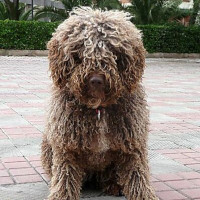 |
Cantabrian Water Dog |
|
He is not recognized by the F.C.I. |
Origin |
Spain | |
Translation |
Francis Vandersteen |
| The Cantabrian Water Dog lives up to its name because it's native to Cantabria and loves the water. This breed originated on the coast of Cantabria, Spain, and has provided complete assistance to their fisherman owners. Indeed, if the Cantabrian had a job, it would be as a sailor, being very comfortable on sailboats and jetties. Unfortunately, many of the roles traditionally fulfilled by the Cantabrian Water Dog have been replaced by technology. So, whereas this active fellow used to carry messages from boat to boat, he is now little more than a fisherman in search of a cell phone. As such, the number of Cantabrian dogs declined sharply in the 20th century. Where they were once common, busy along quays and jetties, they are now a rarity. Indeed, by 2011, there were just 1,200 dogs left to represent the breed. The appearance of the Cantabrian Water Dog is responsible for its nickname, the Wool Dog. Their history is inextricably linked to that of the fishermen working the small fishing ports along the Spanish coast and Iberian Peninsula. Genetically, one of their closest relatives is the Spanish Water Dog, to which they share a similar appearance. However, the Cantabrian is generally smaller and shorter than its Spanish counterpart. The Cantabrian was a working dog that fulfilled many roles around the harbor and fishing boats. For example, one of their roles was to retrieve fish that had spilled into fishermen's baskets. They would also be adept at spotting shoals of fish in shallow waters and guiding their masters to cast their nets. They were also razor guards, playing an important role in reducing the number of vermin on board ships. There were other talents too, such as catching the rope between the boat and the shore, to help tie the boat to the quay. But the Cantabrian's usefulness didn't stop there. They also acted as watchdogs and sometimes as rescuers, helping fishermen who fell into the sea. By the middle of the 20th century, however, many of these roles had become redundant. Modern technologies replaced the Cantabrian and so numbers began to decline. Now they're mainly found as pets around the docks, rather than working animals. There's something almost poodle-like about the wavy hair of this woolly breed. Medium-sized dogs, they are reasonably proportioned, with strong legs and a compact body. Their head is also well proportioned, with a good length of muzzle. They have floppy ears, neither too short nor too long. Cantabrians have a tail of intermediate length, carried high and slightly curved. One of the distinctive features of the Cantabrian is its coat. It's long and woolly (poodle-like). They come in a variety of colors, including cream, fawn, brown and white and black and white. The Cantabrian has a soft mouth (gently scoops up upside-down fish) and piercing eyes as it spots schools of fish. They are an intelligent breed, able to think for themselves and react accordingly. Generally an easy-going breed that likes to be around people, they make good pets provided they get plenty of exercise. However, their roots as a rat-catching dog mean they have a wide range of potential prey, which means they don't necessarily make a good housemate for cats or other small furry animals. |






 English (United Kingdom)
English (United Kingdom)